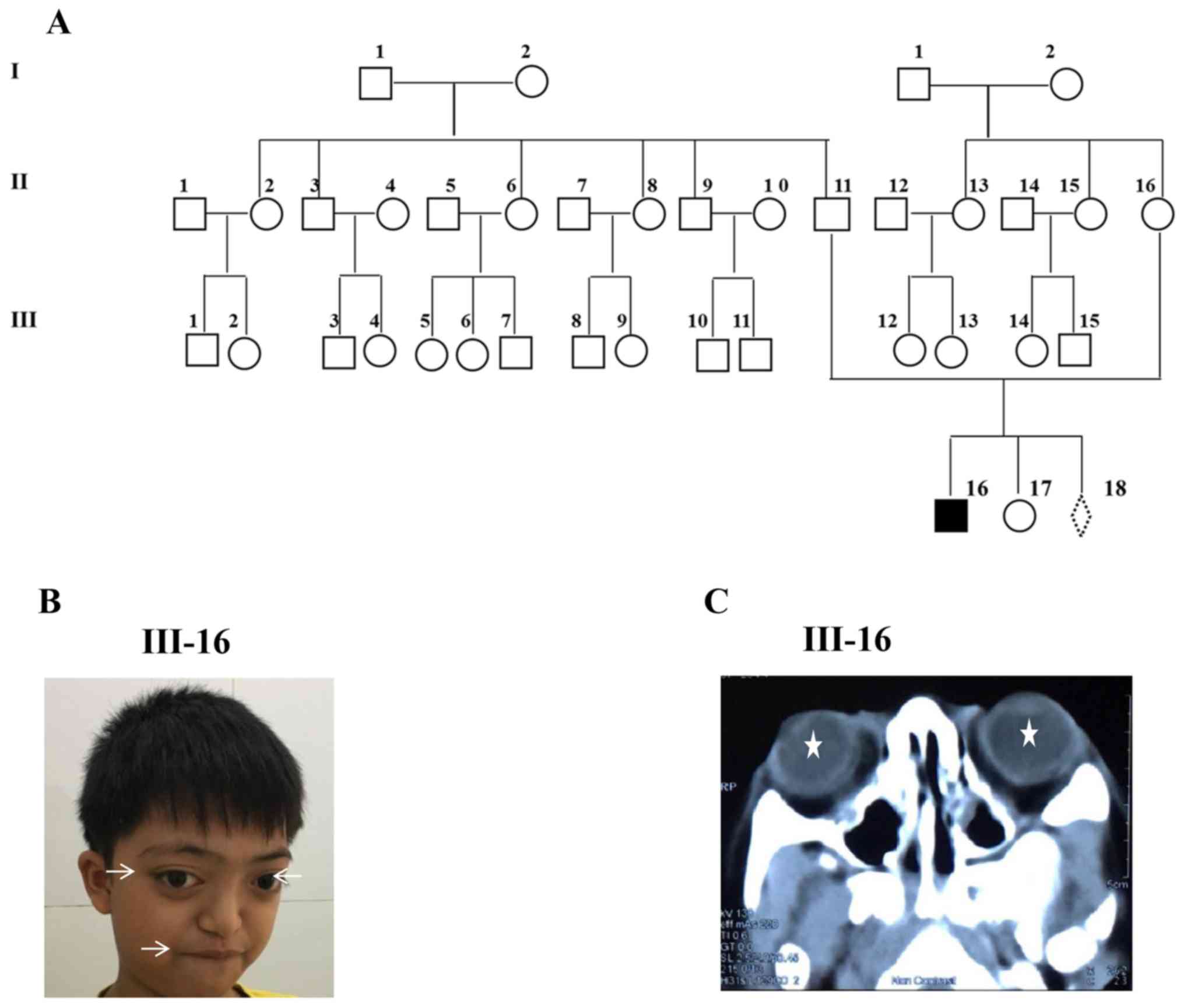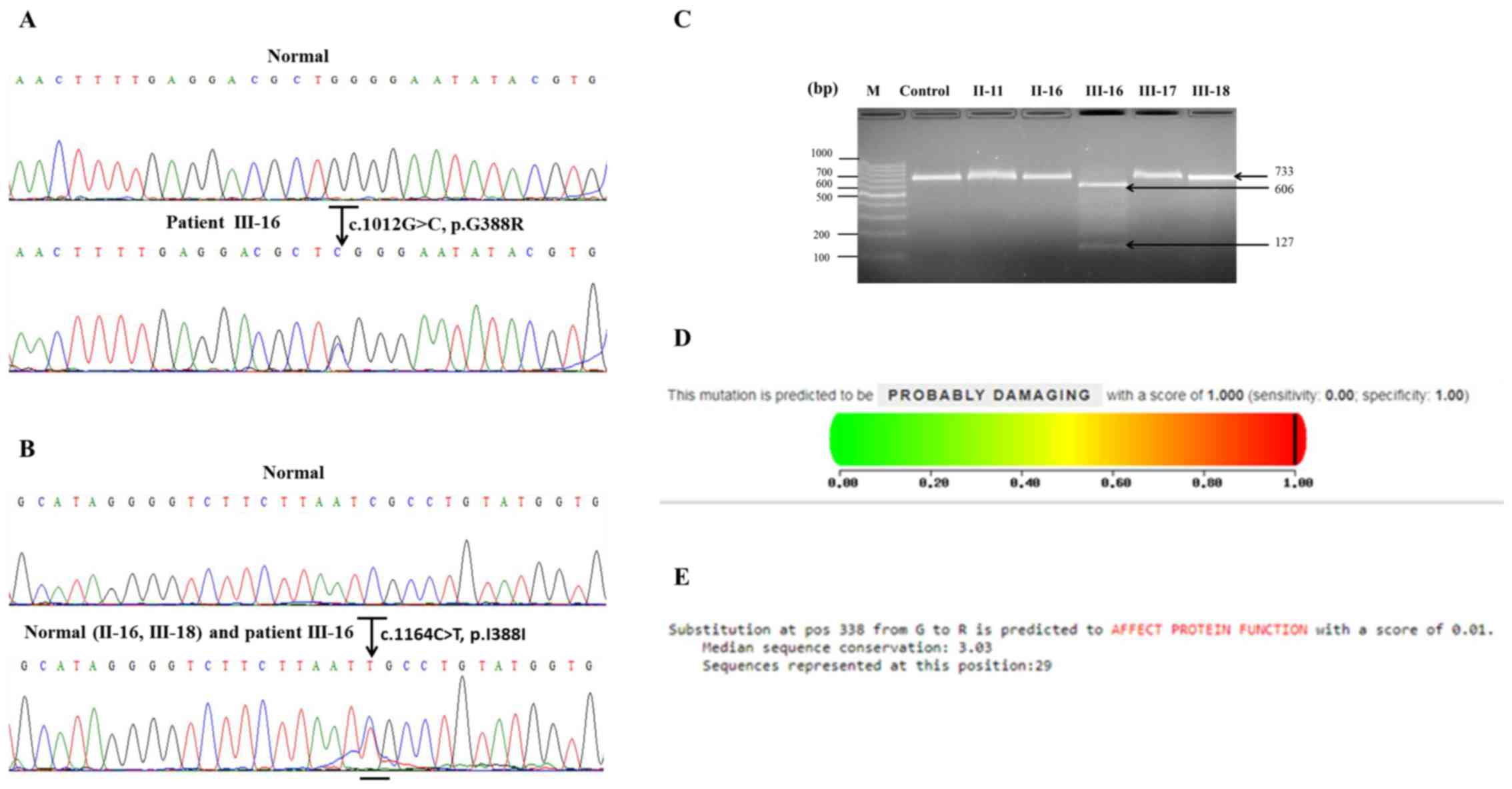|
1
|
Giordano BP, Tuli SS, Ryan SF, Stern M and
Tuli SY: Crouzon Syndrome: Visual Diagnosis. J Pediatr Health Care.
30:270–273. 2016.PubMed/NCBI View Article : Google Scholar
|
|
2
|
Mitulla B, Hinkel GK and Lorenz P: Crouzon
syndrome (Mc K 12350). Kinderarztl Prax. 59:278–280. 1991.(In
German). PubMed/NCBI
|
|
3
|
Liu J, Kwon TG, Nam HK and Hatch NE:
Craniosynostosis- associated Fgfr2(C342Y) mutant bone marrow
stromal cells exhibit cell autonomous abnormalities in osteoblast
differentiation and bone formation. Biomed Res Int.
2013(292506)2013.PubMed/NCBI View Article : Google Scholar
|
|
4
|
Raposo-Amaral CE, Neto JG, Denadai R,
Raposo-Amaral CM and Raposo-Amaral CA: Patient-reported quality of
life in highest-functioning Apert and Crouzon syndromes: A
comparative study. Plast Reconstr Surg. 133:182e–191e.
2014.PubMed/NCBI View Article : Google Scholar
|
|
5
|
Lin Y, Gao H, Ai S, Eswarakumar JVP, Zhu
Y, Chen C, Li T, Liu B, Jiang H, Liu Y, et al: FGFR2 mutations and
associated clinical observations in two Chinese patients with
Crouzon syndrome. Mol Med Rep. 16:5841–5846. 2017.PubMed/NCBI View Article : Google Scholar
|
|
6
|
Korc M and Friesel RE: The role of
fibroblast growth factors in tumor growth. Curr Cancer Drug
Targets. 9:639–651. 2009.PubMed/NCBI View Article : Google Scholar
|
|
7
|
Chae YK, Ranganath K, Hammerman PS,
Vaklavas C, Mohindra N, Kalyan A, Matsangou M, Costa R, Carneiro B,
Villaflor VM, et al: Inhibition of the fibroblast growth factor
receptor (FGFR) pathway: The current landscape and barriers to
clinical application. Oncotarget. 8:16052–16074. 2017.PubMed/NCBI View Article : Google Scholar
|
|
8
|
Touat M, Ileana E, Postel-Vinay S, André F
and Soria JC: Targeting FGFR signaling in cancer. Clin Cancer Res.
21:2684–2694. 2015.PubMed/NCBI View Article : Google Scholar
|
|
9
|
Belov AA and Mohammadi M: Molecular
mechanisms of fibroblast growth factor signaling in physiology and
pathology. Cold Spring Harb Perspect Biol. 5(pii): a015958.
2013.PubMed/NCBI View Article : Google Scholar
|
|
10
|
Jabs EW, Li X, Scott AF, Meyers G, Chen W,
Eccles M, Mao JI, Charnas LR, Jackson CE and Jaye M: Jackson-Weiss
and Crouzon syndromes are allelic with mutations in fibroblast
growth factor receptor 2. Nat Genet. 8:275–279. 1994.PubMed/NCBI View Article : Google Scholar
|
|
11
|
Li ZL, Chen X, Zhuang WJ, Zhao W, Liu YN,
Zhang FX, Ha RS, Wu JH, Zhao C and Sheng XL: FGFR2 mutation in a
Chinese family with unusual Crouzon syndrome. Int J Ophthalmol.
9:1403–1408. 2016.PubMed/NCBI View Article : Google Scholar
|
|
12
|
Katoh M: (2008). FGFR 2 (fibroblast growth
factor receptor 2). Atlas of Genetics and Cytogenetics in Oncology
and Haematology. http://atlasgeneticsoncology.org/Genes/GC_FGFR2.html#LINKS.
Accessed 18 December 2018.
|
|
13
|
Menashe Y, Ben Baruch G, Rabinovitch O,
Shalev Y, Katzenlson MB and Shalev E: Exophthalmus - prenatal
ultrasonic features for diagnosis of Crouzon syndrome. Prenat
Diagn. 9:805–808. 1989.PubMed/NCBI View Article : Google Scholar
|
|
14
|
Schwartz M, Kreiborg S and Skovby F:
First-trimester prenatal diagnosis of Crouzon syndrome. Prenat
Diagn. 16:155–158. 1996.PubMed/NCBI View Article : Google Scholar
|
|
15
|
Kan SH, Elanko N, Johnson D,
Cornejo-Roldan L, Cook J, Reich EW, Tomkins S, Verloes A, Twigg SR,
Rannan-Eliya S, et al: Genomic screening of fibroblast
growth-factor receptor 2 reveals a wide spectrum of mutations in
patients with syndromic craniosynostosis. Am J Hum Genet.
70:472–486. 2002.PubMed/NCBI View
Article : Google Scholar
|
|
16
|
Reardon W, Winter RM, Rutland P, Pulleyn
LJ, Jones BM and Malcolm S: Mutations in the fibroblast growth
factor receptor 2 gene cause Crouzon syndrome. Nat Genet. 8:98–103.
1994.PubMed/NCBI View Article : Google Scholar
|
|
17
|
Bochukova EG, Roscioli T, Hedges DJ,
Taylor IB, Johnson D, David DJ, Deininger PL and Wilkie AO: Rare
mutations of FGFR2 causing apert syndrome: Identification of the
first partial gene deletion, and an Alu element insertion from a
new subfamily. Hum Mutat. 30:204–211. 2009.PubMed/NCBI View Article : Google Scholar
|
|
18
|
Fan J, Li Y, Jia R and Fan X: An inherited
FGFR2 mutation increased osteogenesis gene expression and result in
Crouzon syndrome. BMC Med Genet. 19(91)2018.PubMed/NCBI View Article : Google Scholar
|
|
19
|
Tartaglia M, Valeri S, Velardi F, Di Rocco
C and Battaglia PA: Trp290Cys mutation in exon IIIa of the
fibroblast growth factor receptor 2 (FGFR2) gene is associated with
Pfeiffer syndrome. Hum Genet. 99:602–606. 1997.PubMed/NCBI
|
|
20
|
Ke R, Yang X, Tianyi C, Ge M, Lei J and Mu
X: The C342R mutation in FGFR2 causes Crouzon syndrome with elbow
deformity. J Craniofac Surg. 26:584–586. 2015.PubMed/NCBI View Article : Google Scholar
|
|
21
|
Lapunzina P, Fernández A, Sánchez Romero
JM, Delicado A, Sáenz de Pipaon M, López Pajares I and Molano J: A
novel insertion in the FGFR2 gene in a patient with Crouzon
phenotype and sacrococcygeal tail. Birth Defects Res A Clin Mol
Teratol. 73:61–64. 2005.PubMed/NCBI View Article : Google Scholar
|
|
22
|
Piccione M, Antona V, Niceta M, Fabiano C,
Martines M, Bianchi A and Corsello G: Q289P mutation in the FGFR2
gene: First report in a patient with type 1 Pfeiffer syndrome. Eur
J Pediatr. 168:1135–1139. 2009.PubMed/NCBI View Article : Google Scholar
|
|
23
|
Li X, Park WJ, Pyeritz RE and Jabs EW:
Effect on splicing of a silent FGFR2 mutation in Crouzon syndrome.
Nat Genet. 9:232–233. 1995.PubMed/NCBI View Article : Google Scholar
|
















